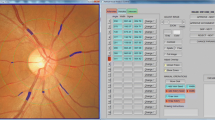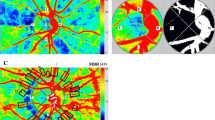Abstract
Purpose of Review
The diameter of retinal vessels is an important source of information about retinal blood flow and metabolism. The purpose of the present study is to review how diameter changes of retinal vessels contribute to the development of diabetic retinopathy and may be a marker of the prognosis of the disease.
Recent Findings
The early stages of diabetic retinopathy are accompanied with dilatation of the diameter of retinal vessels and reduced autoregulation. Diabetic retinopathy also shows regional differences in the macular area and the retinal periphery and accompanying differences in vascular reactivity in these areas. These differences may potentially become an important source of insight into the pathophysiology of the disease in the future.
Summary
Diabetic retinopathy is accompanied with changes in the diameter regulation of retinal vessels. The potential of newly developed techniques for assessing retinal blood flow and metabolism, such as Doppler techniques, adaptive optics, and retinal oximetry, is promising and may potentially contribute to significant advances in our understanding of diabetic retinopathy which remains a major cause of visual impairment.


Similar content being viewed by others
References
Papers of particular interest, published recently, have been highlighted as: • Of importance
Pournaras CJ, Rungger-Brändle E, Riva CE, Hadarson SH, Stefansson E. Regulation of retinal blood flow in health and disease. Prog Retin Eye Res. 2008;27/3:284–330.
Michaelson IC. Retinal circulation in man and animals. Springfield: Thomas; 1954. p. 1–146.
Rassam SM, Patel V, Brinchmann-Hansen O, Engvold O, Kohner EM. Accurate vessel width measurement from fundus photographs: a new concept. Br J Ophthalmol. 1994;78/1:24–9.
Garhofer G, Bek T, Boehm AG, Gherghel D, Grunwald J, Jeppesen P, et al. Use of the retinal vessel analyzer in ocular blood flow research. Acta Ophthalmol. 2010;88/7:717–22.
Tilma KK, Bek T. Topical treatment for 1 week with latanoprost but not diclofenac reduces the diameter of dilated retinal arterioles in patients with type 1 diabetes mellitus and mild retinopathy. Acta Ophthalmology. 2012;90/8:750–5.
Lopez Torres LT, Türksever C, Schötzau A, Orgül S, Todorova MG. Peripapillary retinal vessel diameter correlates with mfERG alterations in retinitis pigmentosa. Acta Ophthalmol. 2015;7:e527–33.
Laties AM. Central retinal artery innervation. Absence of adrenergic innervation to the intraocular branches. Arch. Ophthalmology. 1967;77:405–9.
Bek T. Regional morphology and pathophysiology of retinal vascular disease. Prog Retin Eye Res. 2013;36:247–59.
Pemp B, Schmetterer L. Ocular blood flow in diabetes and age-related macular degeneration. Can J Ophthalmol. 2008;43/3:295–301.
Simonsen SE. The value of the oscillatory potential in selecting juvenile diabetics at risk of developing proliferative retinopathy. Acta Ophthalmol. 1980;58/6:865–78.
Bek T. Immunohistochemical characterization of retinal glial cell changes in areas of vascular occlusion secondary to diabetic retinopathy. Acta Ophthalmol. 1997;75/4:388–92.
Bek T. Glial cell involvement in vascular occlusion of diabetic retinopathy. Acta Ophthalmol. 1997;75/3:239–43.
Misfeldt M, Pedersen SM, Bek T. Perivascular cells with pericyte characteristics are involved in ATP and PGE2 induced relaxation of porcine retinal arterioles in vitro. Invest Ophthalmol Vis Sci. 2013;54/5:3258–64.
Kudryavtseva O, Aalkjaer C, Bek T. Prostaglandin induced changes in the tone of porcine retinal arterioles in vitro involve other factors than calcium activity in perivascular cells. Exp Eye Res. 2015;138:96–103.
Schocket LS, Grunwald JE, Tsang AF, DuPont J. The effect of pregnancy on retinal hemodynamics in diabetic versus nondiabetic mothers. Am J Ophthalmol. 1999;128/4:477–84.
Chen HC, Newsom RS, Patel V, Cassar J, Mather H, Kohner EM. Retinal blood flow changes during pregnancy in women with diabetes. Invest Ophthalmol Vis Sci. 1994;35/8:3199–208.
Larsen M, Colmorn LB, Bønnelycke M, Kaaja R, Immonen I, Sander B, et al. Retinal artery and vein diameters during pregnancy in diabetic women. Invest Ophthalmol Vis Sci. 2005;46/2:709–13.
Lauszus FF, Klebe JG, Bek T, Flyvbjerg A. Increased serum IGF-I during pregnancy is associated with progressino of diabetic retinopathy. Diabetes. 2003;52/3:852–6.
Broe R, Rasmussen ML, Frydkjaer-Olsen U, Olsen BS, Mortensen HB, Hodgson L, et al. Retinal vessel calibers predict long-term microvascular complications in type 1 diabetes. The Dansh Cohort of Pediatic Diabetes 1987 (DCPD1987). Diabetes. 2014;63/11:3906–14.
Pedersen L, Jeppesen P, Knudsen ST, Poulsen PL, Bek T. Improvement of mild retinopathy in type 2 diabetic patients correlates with narrowing of retinal arterioles. A prospective observational study. Graefes Arch Clin Exp Ophthalmol. 2014;252/10:1561–7.
Frydkjaer-Olsen U, Soegaard Hansen R, Simó R, Cunha-Vaz J, Peto T, Grauslund J. Correlation between retinal vessel caliber and neurodegeneration in patients with type 2 diabetes mellitus in the European Consortium for the Early Treatment of Diabetic Retinopathy (EUROCONDOR). Ophthalmic Res. 2016;56/1:10–6.
Klein R, Myers CE, Lee KE, Gangnon R, Klein BE. Changes in retinal vessel diameter and incidence and progression of diabetic retinopathy. Arch Ophthalmol. 2012;130/6:749–55.
Petersen L, Bek T. The diameter response of retinal arterioles in diabetic maculopathy is reduced during hypoxia and is unaffected by the inhibition of cyclo-oxygenase and nitric oxide synthesis. Graefes Arch Clin Exp Ophthalmol. 2016;254/12:2339–46.
Petersen L, Bek T. Preserved pressure autoregulation but disturbed cyclo-oxygenase and nitric oxide effects on retinal arterioles during acute hypoxia in diabetic patients without retinopathy. Ophthalmologica. 2016;235/2:114–20.
Kristinsson JK, Gottfredsdóttir MS, Stefánsson E. Retinal vessel dilatation and elongation precedes diabetic macular oedema. Br J Ophthalmol. 1997;81/4:274–8.
Pemp B, Cherecheanu AP, Garhofer G, Schmetterer L. Calculation of central retinal artery diameters from non-invasive ocular haemodynamic measurements in type 1 diabetes patients. Acta Ophthalmol. 2013;91/5:e348–52.
Godfredsdóttir MS, Stefánsson E, Jónasson F, Gíslason I. Retinal vasoconstriction after laser treatment for diabetic macular edema. Am J Ophthalmol. 1993;115/1:64–7.
Jeppesen P, Sanye-Hajari J, Bek T. Increased blood pressure induces a diameter response of retinal arterioles that increases with decreasing arteriolar diameter. Invest Ophthalmol Vis Sci. 2007;48/1:328–31.
Kohner EM, Patel V, Rassam SM. Role of blood flow and impaired autoregulation in the pathogenesis of diabetic retinopathy. Diabetes. 1995;44/6:603–7.
Jeppesen P, Gregersen PA, Bek T. The age-dependent decrease in the myogenic response of retinal arterioles as studied with the retinal vessel analyzer. Graefes Arch Clin Exp Ophthalmol. 2004;242/11:914–9.
Garhöfer G, Zawinka C, Resch H, Kothy P, Schmetterer L, Dorner GT. Reduced response of retinal vessel diameters to flicker stimulation in patients with diabetes. Br J Ophthalmol. 2004;88/7:887–91.
Frederiksen CA, Jeppesen P, Knudsen ST, Poulsen PL, Mogensen CE, Bek T. The blood pressure-induced diameter response of retinal arterioles decreases with increasing diabetic maculopathy. Graefes Arch Clin Exp Ophthalmol. 2006;244/10:1255–61.
Bek T, Helgesen A. The regional distribution of diabetic retinopathy lesions may predict risk factors for the progression of the disease. Acta Ophthalmol. 2001;79:501–5.
Bek T, Hajari J, Jeppesen P. Interaction between flicker-induced vasodilatation and pressure autoregulation in early retinopathy of type 2 diabetes. Graefes Arch Clin Exp Ophthalmol. 2008;246/5:763–9.
Nguyen TT, Kawasaki R, Kreis AJ, Wang JJ, Shaw J, Vilser W, et al. Correlation of light-flicker-induced retinal vasodilation and retinal vascular caliber measurements in diabetes. Invest Ophthalmol Vis Sci. 2009;50/12:5609–13.
Mandecka A, Dawczynski J, Vilser W, Blum M, Müller N, Kloos C, et al. Diabetes Res Clin Pract. 2009;86/1:51–5.
Lecleire-Collet A, Audo I, Aout M, Girmens JF, Sofroni R, Erginay A, et al. Evaluation of retinal function and flicker light-induced retinal vascular response in normotensive patients with diabetes without retinopathy. Invest Ophthalmol Vis Sci. 2011;52/6:2861–7.
Hammer M, Heller T, Jentsch S, Dawczynski J, Schweitzer D, Peters S, et al. Invest Ophthalmol Vis Sci. 2012;53/7:4063–8.
Felder AE, Wanek J, Blair NP, Joslin CE, Brewer KC, Chau FY, et al. The effects of diabetic retinopathy stage and light flicker on inner retinal oxygen extraction fraction. Invest Ophthalmol Vis Sci. 2016;57/13:5586–92.
Mehlsen J, Jeppesen P, Erlandsen M, Poulsen PL, Bek T. Lack of effect of short-term treatment with amlodipine and lisinopril on retinal autoregulation in normotensive patients with type 1 diabetes and mild diabetic retinopathy. Acta Ophthalmol. 2011;89/8:764–8.
Pemp B, Garhofer G, Weigert G, Karl K, Resch H, Wolzt M, et al. Reduced retinal vessel response to flicker stimulation but not to exogenous nitric oxide in type 1 diabetes. Invest Ophthalmol Vis Sci. 2009;50/9:4029–32.
Kaya MY, Petersen L, Bek T. Lack of effect of nitroglycerin on the diameter response of larger retinal arterioles in normal persons during hypoxia. Graefes Arch Clin Exp Ophthalmol. 2016;254/2:277–83.
Mishra A, Newman EA. Inhibition of inducible nitric oxide synthase reverses the loss of functional hyperemia in diabetic retinopathy. Glia. 2010;58/16:1996–2004.
Dorner GT, Garhofer G, Kiss B, Polska E, Polak K, Riva CE, et al. Nitric oxide regulates retinal vascular tone in humans. Am J Physiol Heart Circ Physiol. 2003;285/2:H631–6.
Bek T. Diabetic maculopathy caused by disturbances in retinal vasomotion. A new hypothesis. Acta Ophthalmol. 1999;77/4:376–80.
Bek T. Lack of correlation between short-term dynamics of diabetic retinopathy lesions and the arterial blood pressure. Graefes Arch Clin Exp Ophthalmol. 2011;249/2:267–71.
Bek T, Jeppesen P, Kanters JK. Spontaneous high frequency diameter oscillations of larger retinal arterioles are reduced in type 2 diabetes mellitus. Invest Ophthalmol Vis Sci. 2013;54/1:636–40.
Taylor E, Dobree JH. Proliferative diabetic retinopathy. Site and size of initial lesions. Br J Ophthalmol. 1970;54/1:11–8.
Lahrmann C, Bek T. Foveal haemorrhages in diabetic retinopathy. Clinical characteristics and visual outcome. Acta Ophthalmol. 2000;78/2:169–72.
Hove MN, Kristensen JK, Lauritzen T, Bek T. Quantitative analysis of retinopathy in type 2 diabetes. Identification of prognostic parameters for developing visual loss secondary to diabetic maculopathy. Acta Ophthalmol. 2004;82/6:679–85.
Skov Jensen P, Jeppesen P, Bek T. Differential diameter responses in macular and peripheral retinal arterioles may contribute to the regional distribution of diabetic retinopathy lesions. Graefes Arch Clin Exp Ophthalmol. 2011;249/3:407–12.
Jørgensen CM, Bek T. Lack of differences in the regional variation of oxygen saturation in larger retinal vessels in diabetic maculopathy and proliferative diabetic retinopathy. Br J Ophthalmol. 2016; doi:10.1136/bjophthalmol-2016-308894.
Tayyari F, Khuu LA, Flanagan JG, Singer S, Brent MH, Hudson C. Retinal blood flow and retinal blood oxygen saturation in mild to moderate diabetic retinopathy. Invest Ophthalmol Vis Sci. 2015;56/11:6796–800.
• Luft N, Wozniak PA, Aschinger GC, Fondi K, Bata AM, Werkmeister RM, et al. Measurements of retinal perfusion using laser speckle flowgraphy and Doppler optical coherence tomography. Invest Ophthalmol Vis Sci. 2016;57/16:5417–25. The study shows how a combination of the linear flow and vessel diameters can be used to quantify blood flow in single retinal vessels.
Bek T. Fine structure in diabetic retinopathy lesions as observed by adaptive optics imaging. A qualitative study. Acta Ophthalmol. 2014;92/8:753–8.
Arichika S, Uji A, Murakami T, Suzuma K, Gotoh N, Yoshimura N. Correlation of retinal arterial wall thickness with atherosclerosis predictors in type 2 diabetes without clinical retinopathy. Br J Ophthalmol. 2017;101/1:69–74.
• Jørgensen CM, Hardarson SH, Bek T. The oxygen saturation in retinal vessels from diabetic patients depends on the severity and type of vision threatening retinopathy. Acta Ophthalmol. 2014;92/1:34–9. The study shows that the oxygen saturation in retinal venules increases with increasing severity of diabetic retinopathy.
Acknowledgments
The study was supported by the VELUX Foundation.
Author information
Authors and Affiliations
Corresponding author
Ethics declarations
Conflict of Interest
Toke Bek declares that he has no conflict of interest.
Human and Animal Rights and Informed Consent
This article does not contain any studies with human or animal subjects performed by the author.
Additional information
This article is part of the Topical Collection on Microvascular Complications—Retinopathy
Rights and permissions
About this article
Cite this article
Bek, T. Diameter Changes of Retinal Vessels in Diabetic Retinopathy. Curr Diab Rep 17, 82 (2017). https://doi.org/10.1007/s11892-017-0909-9
Published:
DOI: https://doi.org/10.1007/s11892-017-0909-9




